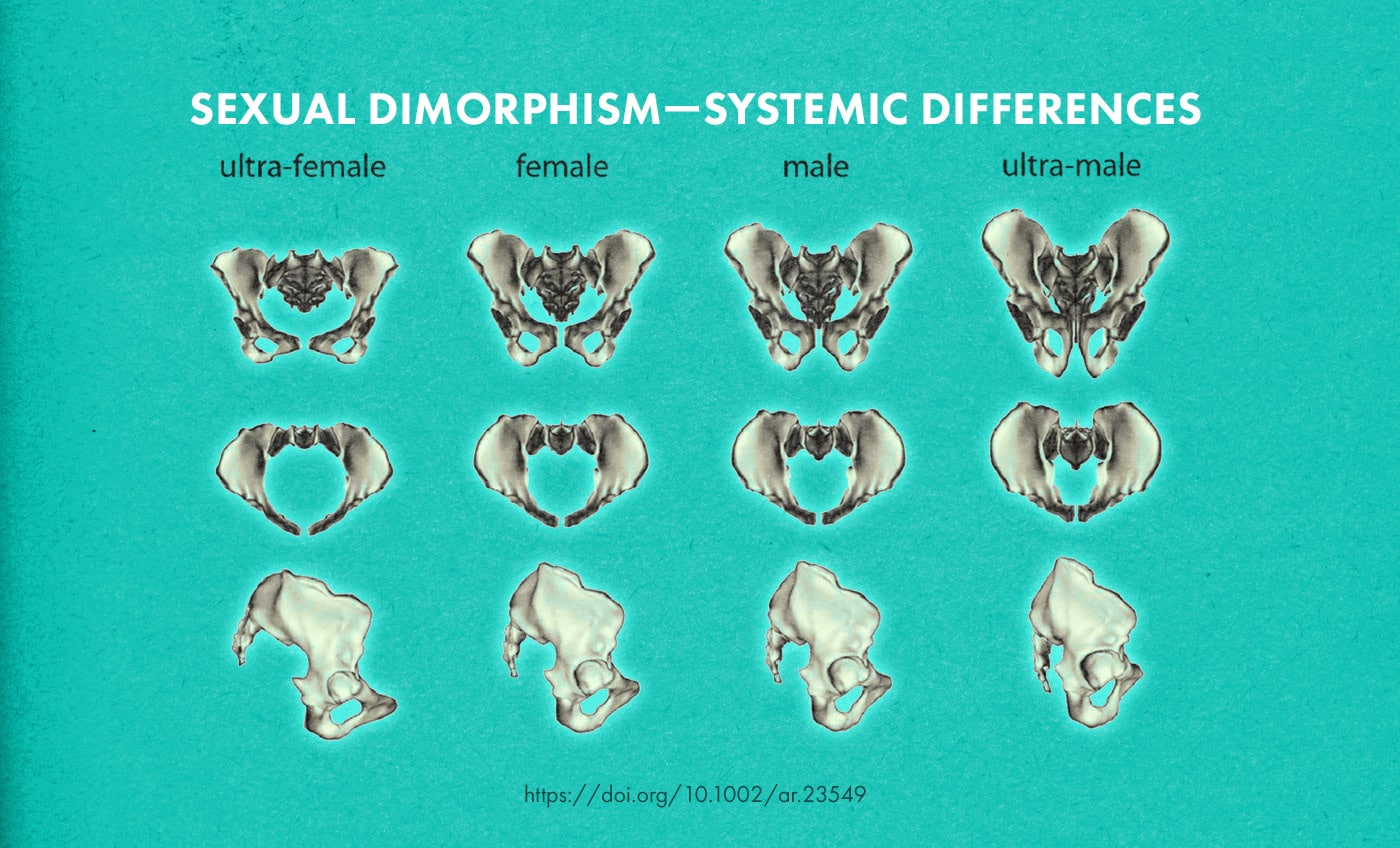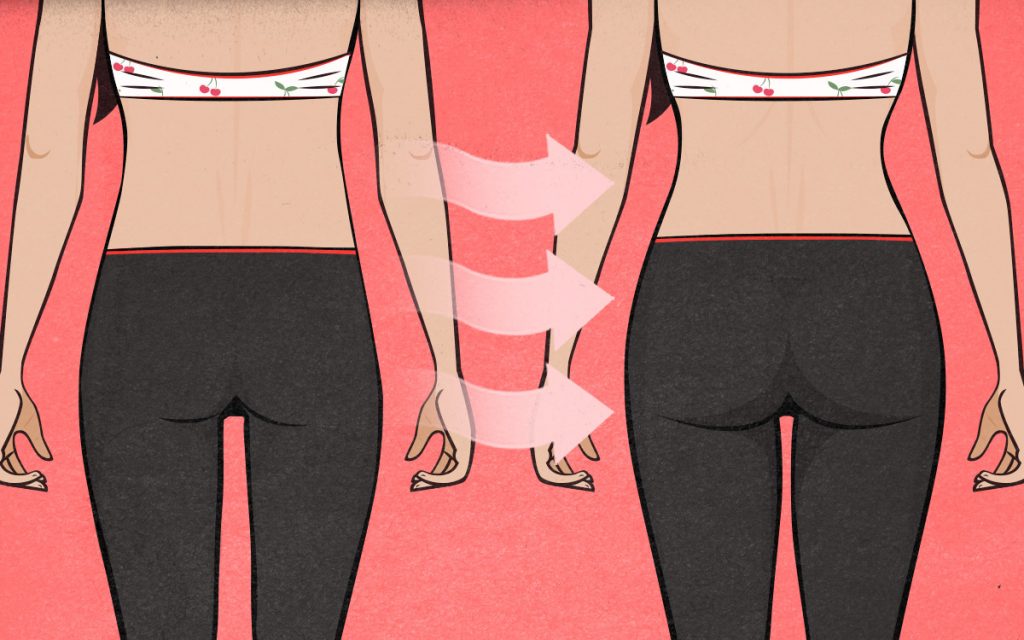
How to Get Wider, Curvier Hips Naturally And Fast
If you’re a naturally skinny woman with naturally narrower hips, you might be wondering: is it even possible to get bigger, wider hips? Why do some females have narrower hips? Are there any exercises to widen the hips? What’s all this talk about the waist-to-hip ratio, and how can I improve my ratio naturally?
These are questions we get a lot. So inside this article, we’ll be talking about why so many women want to have wide hips with a small waist, what we can’t change, what we can change, and some action steps you can take today to quickly start adding inches to your hip measurement to immediately start improving your waist-to-hip ratio.
- Bigger, Wider Hips Compared To What?
- Why Do So Many Women Want Wider Hips?
- How to Get A Better Waist-to-Hip Ratio
- How To Build A Bigger, Curvier Butt
- Understanding Your Glutes: The Maximus, Medius & Minimus
- The Best Exercises For Building a Bigger Hips With The Glutes
- Frequently Asked Questions About Wider & Curvier Hips
- Summary
Bigger, Wider Hips Compared To What?
First, we need to get on the same page. When we say “big, wide hips,” what do we mean? Big and wide compared to what? We’re not talking about how big your hips are in objective measurements. And we aren’t even talking about how big or wide your hips are compared to other women.
When women talk about “big hips,” they’re usually intuitively talking about having wide hips compared to their waist.

Along with having strong shoulders, this contrast between waist and hip size creates the coveted “hourglass” body shape that women like Marilyn Monroe, Scarlett Johansson, Brigitte Bardot, and Beyoncé are famous for. But as you can see, Brigitte Bardot actually has a fairly slender structure overall, including fairly small hips. It’s just that they’re large compared to her even smaller waist.
By this standard, a woman with a waist-to-hip ratio less or equal to 0.7 has wide hips. To figure out your own waist-to-hip ratio (WHR), start by measuring your waist circumference at its narrowest point and your hip circumference at its widest point, like so:
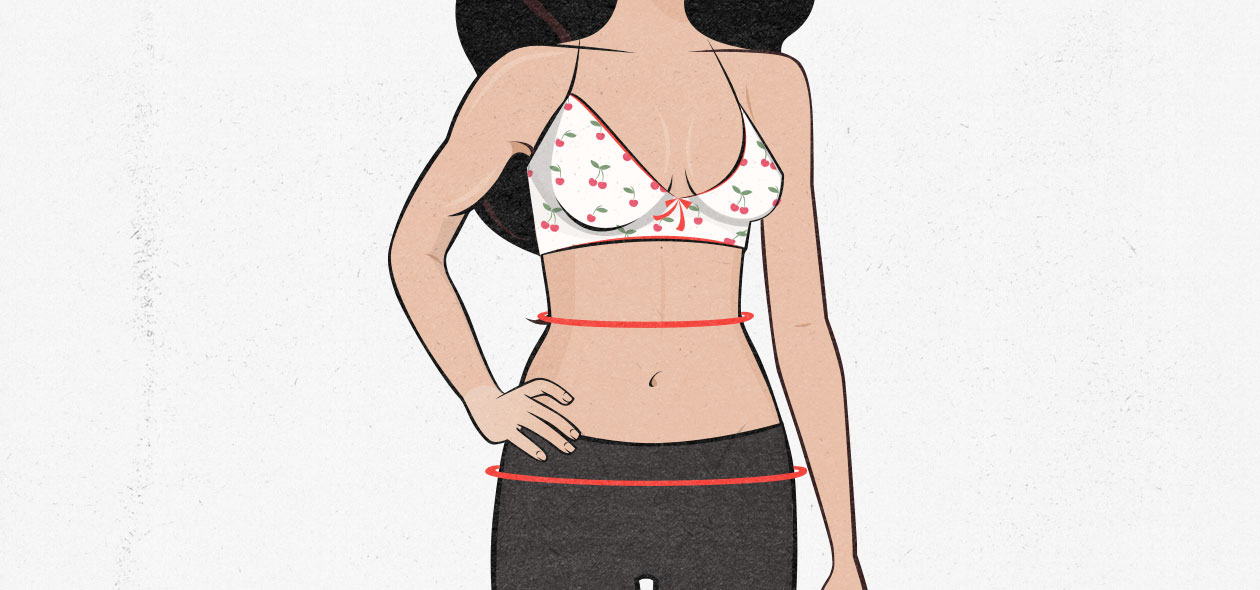
Then divide your waist circumference by your hip circumference, giving you your waist-to-hip ratio. For example, let’s say we have a woman with a 26-inch waist and 31-inch hips. She would divide her waist measurement by her hip measurement (26/31) to get a ratio of 0.838.
Don’t get too bogged down in the specific numbers, though. Having wide hips and a small waist shows that someone is strong and healthfully lean. It shows that someone is in shape. You don’t need to game the system. All you need to do is become stronger while staying within a healthy body-fat range.
With that said, when we surveyed both men and women, there was indeed a preference for women with proportionally bigger glutes. If you want to intentionally emphasize your hips by building up large muscles surrounding the hip bone, that may indeed improve your appearance. Again, though, the trick is to simply focus on getting stronger at the lifts that work your glute muscles.
Why Do So Many Women Want Wider Hips?
Most women who exercise are looking to build bigger hips. When we surveyed our readers, almost two-thirds wanted to emphasize their hips. It’s one of the most common questions we get and has been for the past ten years.
One hypothesis was that it was a cultural trend to want wider hips. There is some evidence that culture can shift our body-shape preferences, but these shifts are quite small. In fact, our natural instincts might be towards even more extreme proportions (study). This means that our current culture, with more people overweight, is subtly making us to prefer hips that are less wide because it looks more normal. So if anything, wide hips being desirable is biological, and our culture tends to downplay it.
A hypothesis with more research behind it is that wide hips are so attractive because they’re so healthy. Having big hips with a small waist is a great sign of health. The better the ratio, the healthier the person looks. This isn’t unique to women. It’s directly comparable to how women prefer more muscular men (up to a point) and how various male proportions indicate different health markers, such as a man appearing more healthy when he builds broader shoulders.
Aside from being leaner and with more hip muscles, having wider hip bone structure may also signal femininity. In a 2017 paper, researchers labelled wider hips as “ultra-female” and taller, narrower hips as male. This is because women need wider hips for childbearing.
“Most of these sex differences appear to be adaptations to the obstetric demands in females as they enlarge the birth canal.”
“sex-specific pubertal growth of the pelvis is due mainly to steroid hormones”
Long story short, as a female, having a higher waist-to-hip ratio will make you look stronger, fitter, and healthier. As a result, it will make you look more attractive. Win-win.
What Does Hip-to-Waist Ratio Have to Do With Health?
A woman’s waist-to-hip ratio is signalling how much muscle she has; it’s signalling her genetics; it’s hinting at whether she spends her days exercising or sitting; and it’s even signalling fertility (study) and youthfulness (study).
After all, as women get older, they tend to become less physically active, a sub-par diet takes it’s toll, and so their hips tend to become less muscular while their waistlines expand. This is preventable (and reversible), but the correlation is still strong.
Because of these massive health implications, even the World Health Organization (WHO) published a report on waist-to-hip ratio. Their researchers think that a waist-to-hip ratio above 1.0 can accurately indicate predict a woman’s cardiovascular health, whether they have diabetes, and even if they’re at risk of getting certain cancers (report).
Side note: Interestingly, the WHO report also touches on ethnic differences in the waist-to-hip ratio. They reference three different studies finding that women of Asian descent naturally store more fat around the vital organs in their waist (visceral fat), and so they benefit from having even smaller waists (in terms of health) when compared against women of European, African, and Middle-Eastern descent. This ensures that any unhealthy visceral fat is minimized. So if you’re of Asian descent, you should definitely aim to have lean waist, and thus a lower ratio than most averages.
This is why so many people find big hips and small waists in women so desirable, both in themselves and in others. They’re naturally drawn to these signals of health, youth, and athleticism.
Of course, this also has a huge impact on attractiveness. Research has been pounding a loud drum saying that sexiness is conspicuous health. The more obvious it is that you’re healthy, the sexier you’ll look. (We’ve written about this extensively in our article about the most attractive female body.) Of course, this all happens on a subconscious, intuitive level, and most people don’t realize they’re instinctively being attracted to health markers.
This intuition is staggeringly universal. Devendra Singh, a researcher and former professor of psychology from the University of Texas, said that these judgments of health and attractiveness are found in both men and women, from a diverse age range of 18–85, and span across the many different ethnic backgrounds studied (Afro-American, Mexican American, Euroamerican) (study). It spans across different periods of history as well. Researchers have studied sculptures made in ancient India, Africa, Egypt, and Greece that reflect the understanding that women had a much lower waist-to-hip ratio than men .
Some research has even found similar findings by looking back and studying the Miss Pageant competition from 1921 and onwards, as well as the issues of Playboy. Putting my own opinions about the Pageantry and Playboy aside, there’s some lessons we can learn from this research. For example, the lowest waist-hip-ratio found in Playboy was 0.529, the highest was 0.844 and the mean is 0.677 (study). This lines up perfectly with what the WHO considers healthy.
This shows us that men are finding the women with the healthiest waist-to-hip ratio to be the sexiest. So if you build a healthier ratio, you’ll also be building a sexier ratio, and vice versa.
In another study, researchers discovered that women “sucked in” their stomachs when trying to appear more attractive (study). This hints that women instinctively understand that their waist-hip-ratio affects how attractive they look.
Gaming The System Doesn’t Work
Having wide hips alongside a small waist is so desirable because it’s so healthy. Yes, you can try to game the system by focusing on surface-level solutions, such as getting butt implants. And according to one online poll, over half of the women surveyed edited their photos before posting to social media like Instagram (link & link).
But don’t do it! Something will often look “off” if you try to fix it at a surface level instead of on a deeper level. And if something manages to trick someone in photos, it won’t translate to real life.
Both men and women have great intuition when it comes to these indicators of health. There’s also something called the uncanny valley, where if something looks almost but not quite natural, then it gives us a strange feeling.
There’s much more to a woman’s body shape than just her waist-to-hip ratio (study). If you build up your hips naturally by squatting, for example, then you’ll also be building up bigger adductors and quads, as well as strengthening your transverse abdominis muscles. If you build bigger hips with deadlifts and hip thrusts, then your hamstrings will grow along with your hips. Again, there are many factors that go along with building bigger hips.
The same is true with a narrow waist. There’s a difference between being underweight versus being lean but athletic.
We’ve been looking at bodies our entire lives. We intuitively understand what looks healthy, athletic, and attractive. As a result, the best way to improve our appearance is to improve ourselves from the inside out.
It’s best to build bigger hips and a smaller waist the genuine way—by focusing on becoming stronger, becoming fitter, eating a good muscle-building diet that is healthy, improving our lifestyles, and improving our sleep habits.
The Best Waist-to-Hip Ratio
The short answer is that a waist-to-hip ratio of 0.7 is ideal. First, there’s evidence that a waist-to-hip ratio of 0.7 is what looks the most healthy and attractive to both men and women (study). Second, that’s also the ratio that’s generally considered to indicate the best overall health (study). Finally, a study published in 2010 shows that a ratio of 0.7 is what best activates the neural reward centres in men’s brains (study).
The long answer is that it isn’t quite that simple. A 0.7 ratio isn’t the final be-all answer. As we mentioned above, there are several different factors that contribute to how healthy and attractive a woman appears.
But first, two things are more or less agreed upon:
- The healthiest body composition is the sexiest body composition
- A remarkably low waist-to-hip ratio is considered the most attractive. (study)
Here’s where things get complicated: not all women have the same bone structure. Some women have a broader bone structure, others have a thinner bone structure. Some women develop an hourglass figure during puberty due to their bone structure or body fat storage patterns… but many don’t. Hourglass figures look stereotypically feminine, but they’re actually one of the rarer body types today. Many women with hourglass figures had to deliberately develop those curves with exercise and diet.
This means that it’s possible to be totally healthy, with a good balance of muscle mass and body fat, but to have a bone structure that makes it way harder to get the ideal WHR. For example, here’s a woman who’s lean, strong and healthy yet has a structurally wider waist:
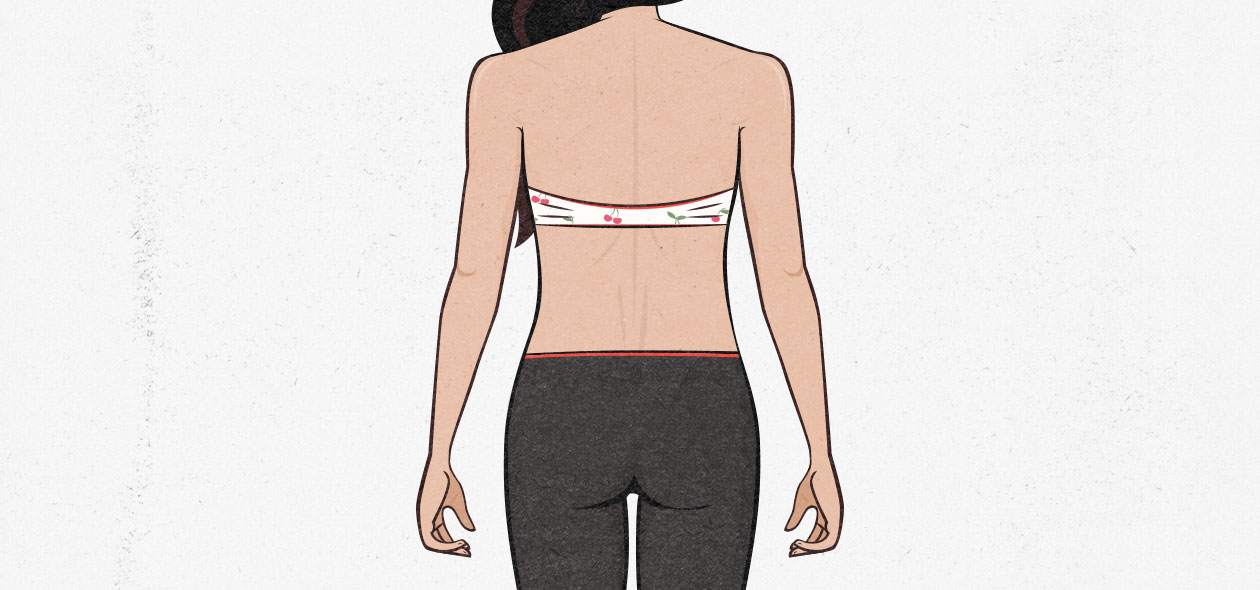
It’s also possible to have the ideal ratio while being clinically underweight or overweight. For example, here’s a woman who’s underweight, with a very small amount of muscle mass and strength, but she still has the ideal waist-to-hip ratio:
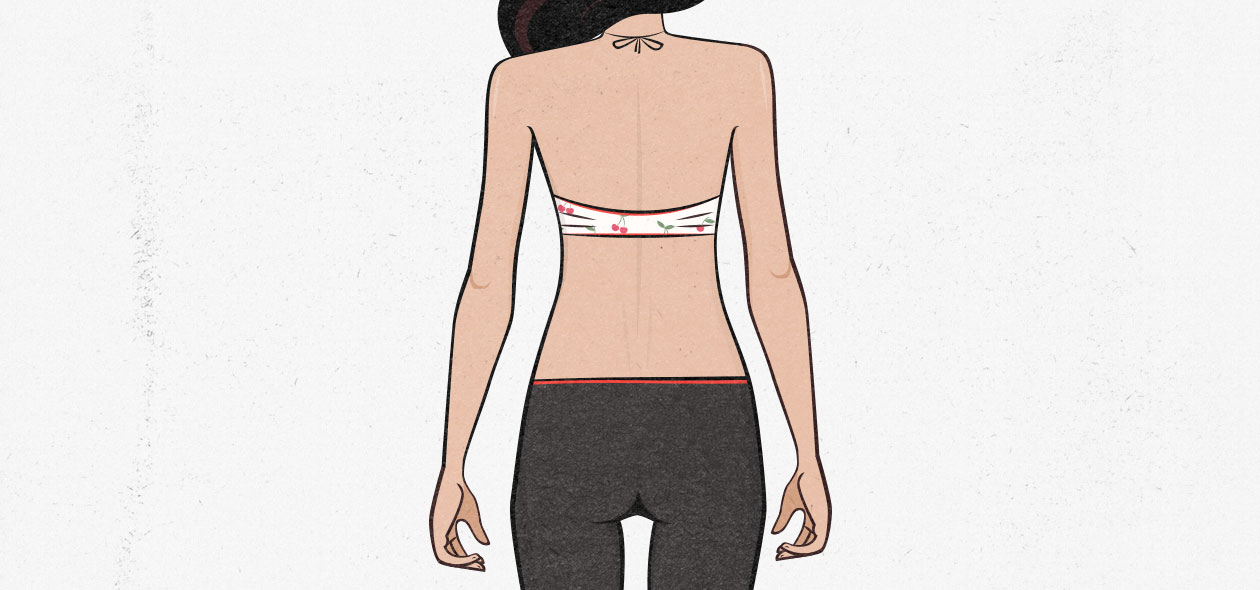
So if this is all about health, are the genuinely healthy people the most attractive? Or is it the people who just have genetically curvier body proportions?
Some studies show that proportions matter most, whether or not that person is healthy (study). Other studies show that it’s more attractive to have a healthy weight and a relatively lean waist regardless of what waist-to-hip ratio that happens to result in. (study).
Based on the evidence, we would argue that you should aim to get the best of both worlds.
If you have naturally smaller hip bones, build extra muscle to round them out and get curvier proportions. You’ll get the added benefit of that muscle too, and muscle is one of the most underrated health markers right now (study). Having a butt that’s “too” strong or “too” athletic or “too” round isn’t a real thing. A strong butt is great for your health, it reduces lower back pain, reduces your risk of injury, increases your athleticism, and it will be great for your appearance.
Yes, building wider hips is going to be harder for naturally skinny women, or women who have naturally thinner hips. However, even women who struggle to gain muscle have a fairly high genetic muscular potential. Furthermore, most of their muscle gains will come within their first couple years of lifting weights (due to a phenomenon called newbie gains).
If you have naturally wider hips but your waist is larger, then you will get curvier proportions by burning off fat. The gameplan might be to walk more, eat less processed foods, and include more whole-foods.
You Can’t Change the Bone Structure of Your Hips
If you haven’t guessed yet, we can’t change our hip bone structure. Bone structure is almost entirely determined by your genetics and health as a young woman. Your mother’s health likely factors into this. Once your hips are finished growing, that’s it. Because your hip potential is in your genetics, the female pelvic shapes are already starting to widen compared to males as early as 26 weeks in gestation (study)!
Interestingly, it does seem like the shape of your hips can modestly adapt to the activity and stress you put on them as a kid. According to this study, women who are more active growing up are more likely to develop the heart-shaped hip structure that’s more common men. 24% of the women had that heart-shaped hip, while the majority of women had a more rounded hip shape (study).
Some rare women are blessed with remarkable genetics, with naturally broad hip bones and a tinier waist. Women with genetics like these won’t need to build up as much muscle in their hips in order to reach their waist-to-hip ratio goals to boost their attractiveness.
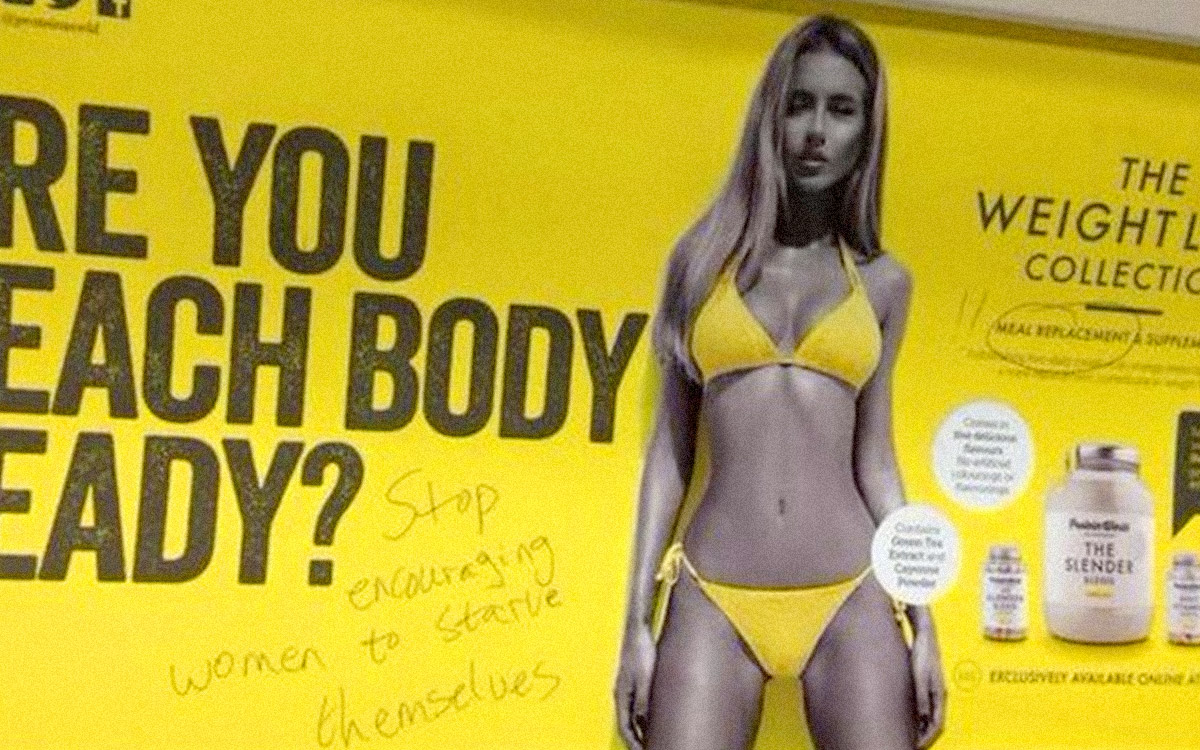
An example of this is the vegan model Renee Somerfield, who was part of a recent ad campaign that was criticized for body shaming because those critics considered her natural body shape too “unrealistic.” Despite the irony of body-shaming someone they claim is body-shaming others, she has a healthy body weight in terms of BMI and she said she exercises 4–5 times a week.
But You Can Still Improve Your Waist-to-Hip Ratio
The good news is that every woman can improve their hip proportions without changing the bone by building up the muscles around their hips while keeping a lean waist.
Check out Aomi, who’s graciously allowed us to share her before and after photos of getting bigger hips. She gained 3″ on her hips while doing our Bony to Bombshell program, which put her ratio even better than the 0.7 target.
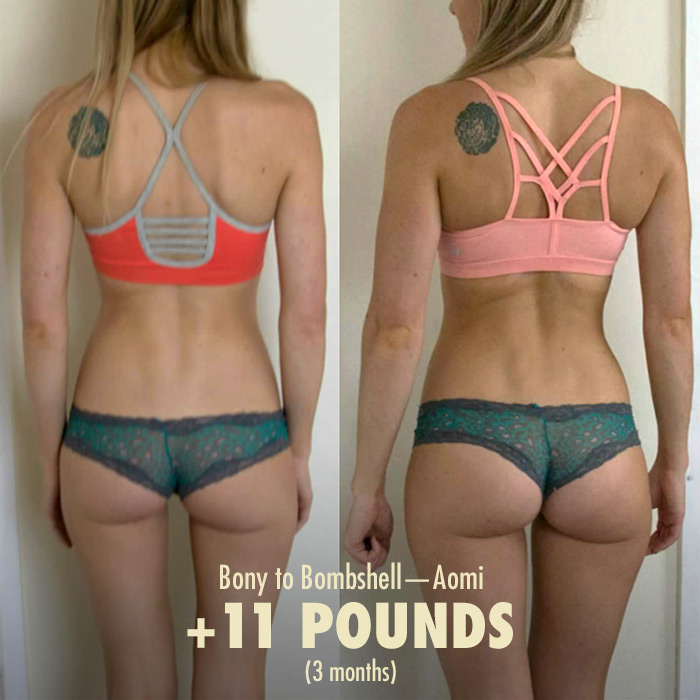
How to Get A Better Waist-to-Hip Ratio
Build Bigger Butt Muscles & Keep Your Waist Lean
Many women with great genetics and who eat well store their fat in their hips. They might also be more naturally muscular. But on our site, we’re committed to helping naturally skinny “ectomorph/banana” women build muscle. So if that’s you, the chances are that you’ll need to focus on building more muscle, not just trimming off extra belly fat.
So let’s jump right to the important part:
How To Build A Bigger, Curvier Butt
The Four Muscle-Growth Principles
Scientific research has revealed a lot about building muscle. We know that to build muscle you need to encourage your muscles to grow stronger by stressing them (lifting weights is the most effective approach), you need to eat enough protein (about 1 gram per pound bodyweight per day is ideal), and in order to gain weight, and you need to eat enough calories above and beyond what you normally eat (about 250 extra calories per day will yield about 0.5 pounds of weight gain each week). You also need enough quality sleep to allow your body to recover and grow.
Building bigger, curvier hips through muscle is all about balancing those four muscle-building principles. You could be doing the world’s best butt workout, but if you aren’t eating enough protein and calories, your body won’t have the extra building blocks it needs to grow.
And vice versa. If you eat the best muscle-building diet, but you’re not sufficiently stressing your muscles, you’ll just gain fat. Or if you’re stressing your muscles enough but not in the right places, such as doing bicep curls, you’ll wind up only growing those specific areas.
Want to Grow Your Butt? Then Train Like It
No amount of cardio will help you build bigger, curvier hips. This is because cardio is designed to help you develop better cardiovascular fitness, not to build muscle in your hip area.
The best way to get better at a specific thing is to train at that specific thing. This is called training specificity, and it’s something beginners don’t often consider. If you want to run faster, all the bench pressing in the world won’t help, you’ll make better progress if you practice running. Similarly, if you want to build a killer butt, all the yoga in the world won’t help with that—yoga’s best adaptation is better diaphragmatic control.
Anyways, when it comes to building bigger, curvier hips, we’re talking about building bigger muscles. You should be doing a bodybuilding program, i.e., a program specifically designed to help you build up a bigger, stronger body. And that bodybuilding program should be one that puts extra emphasis on your hips, since that’s where you most want to grow.
Most exercise programs don’t have that goal in mind. Even though building big hips is so universally appealing, many women in today’s society are coming at this from the other angle: they have naturally big hips and they already have enough muscle… but need to work hard at shrinking their waists.
Most weight training programs focus on either strength training (such as StrongLifts 5×5, Starting Strength, and Girls Gone Strong). However, these programs are designed to make you stronger for your size. Strength training programs aren’t designed to make your muscles bigger. The main adaptation from strength training is something called “neural gains,” which is when learn to contract more of your muscle fibres simultaneously. You’ll certainly build bigger hips, but it’s not the most efficient way to do it.
The other common approach is to focus on general fitness (such as CrossFit, P90X, Insanity, Sweat, Spin, and Body Pump) rather than on becoming bigger and curvier. Again, these programs aren’t designed to help you build bigger hips. While you might get some glute gains, especially if you’re a total beginner, you’ll be leaving so much opportunity on the table.
If you’ve been struggling to build bigger hips, we recommend going straight to a bonafide hip bulking program—a program that’s specifically designed to increase the size of the muscles in your hips (such as your glutes).
What Workout Programs Are Best for Building Bigger Hips?
For the best overall muscle size development, you’ll want a program that focuses more on muscle hypertrophy. You could also call these “bodybuilding” programs, depending on how you define bodybuilding. The more accurate term for exercise that’s designed to stimulate muscle growth is hypertrophy training, though.
You also want a program that is designed specifically for women. That will ensure that it has the right exercises, has higher rep ranges, more overall volume, shorter rest times, and relies less on upper-body strength. For example, a classic barbell deadlift will generally help a man build up much bigger glutes, whereas with women their grip strength and spinal erector strength will often be their limiting factor, which means their upper body will get most of the growth stimulus.
Finally, you may want a women’s program that puts special emphasis on your hips, which is in all likelihood—since you’re reading this article—the area that you’re most keen on developing. Our Bony to Bombshell Bulking Program is an example of a hypertrophy training program designed for women who are trying to build bigger muscles.
For example, here’s what Ioulia was able to accomplish with a few months of training with us. Your results may vary, of course, and this is just one example, but you can see other women’s weight gain transformations here.

Your Glutes Must Become Strong & Athletic For Them To Be Bigger & Rounder
To get the roundest, fullest, and most aesthetic butt, there are no shortcuts. You will need to build genuinely strong and athletic hips.
Strong hips aren’t just for show, and your training needs to reflect that. Aside from being more attractive, strong hips are also versatile. For optimal shape, size and roundness, you need to work your hip muscles through a large range of motion and using a wide variety of exercises that hit all the various muscles, and all the various fibres in those muscles.
This means squatting, deadlifting, and doing accessory exercises for your hips (such as hip thrusts or glute bridges). You might not need all three of those movement patterns to build bigger hips, but that’s what will give you the fastest and most reliable glute growth. You’ll also develop a versatile strength that way.
Understanding Your Glutes: The Maximus, Medius & Minimus
Growing the Glute Maximus
The gluteus maximus is the largest and strongest of the glute muscles and it has the most potential to grow. Its main job is to thrust the hips forward. These are the glute muscles that would get most worked when doing squats, deadlifts, and hip thrusts, all of which require you to thrust your hips forward. The glute maximus can also help to rotate the thigh and move the leg away from the body.
Because the maximus is so large, for the best shape it’s best to try and use a variety of exercises to hit both the upper and lower fibres of it. As you can probably guess, that means doing a variety of squat, deadlift, and hip isolation exercises. And because this is by far the largest glute muscle, this is the best way to increase the size of your hips.
However, we can take this further.
Growing the Glute Medius and Glute Minimus
These two glute muscles mainly help to move your legs away from your body, but they can also help rotate your legs. Fortunately, these will get stimulated during your compound lifts, so as long as they’re activating properly, you likely won’t need to target them directly (although you certainly can!).
Hip Motions & Exercises
All three glute muscles together contribute to these four fundamental motions:
Hip Motion #1: Hip Extension
It looks like: Swinging your leg back behind you
Exercise Example: Bird Dog
Hip Motion #2: Hip External Rotation
It looks like: Rotating your hips outwards
Exercise Example: Clamshell
Hip Motion #3: Hip Transverse Abduction
It looks like: Lifting your leg away from your body
Exercise Example: Side Lying Leg Raise
Hip Motion #4: Posterior Pelvic Tilt
It looks like: Your tailbone comes down as your hips move forward like a thrust motion
Example Exercise Barbell Hip Thrust
You can see the problem with only squats or deadlifts for a big butt. Those exercises don’t incorporate and build strength in every motion the butt is capable of.
Why Range of Motion & Form Matters for Optimal Hip Muscle Growth
Let’s say you’re a beginner and want to try doing the hip thrust. You watch a Youtube video, and their hips dip pretty low at the bottom of the movement. So you try and do that too. But to get that extra range of motion, you let your pelvis disconnect from your ribs to get it lower. It feels like a larger range of motion, but that extra movement didn’t come from your hips, it came from your back. That’s not the end of the world, but it’s also not quite ideal for stimulating the muscles you’re trying to grow.
Instead of trying to sink as low or thrust as high as you can, focus on stretching and contracting the muscles in your hips. Worry less about what it looks like, more about what it feels like. As the weeks go by, and as your butt grows bigger, you’ll gain more range of motion in your hips. You’ll be able to lift with a larger range of motion.
This is true with all of your lifts. As you get better at lifting weights, try squatting and deadlifting deeper, too. This often does a better job of activating a wider variety of muscles. It’s also great for giving your hips a greater growth stimulus. When we sink deeper into a lift, we challenge our muscles at longer muscle lengths, stimulating more muscle growth. Quite a lot more muscle growth, too. As we explain in this article, some studies show 2–3 times more growth from lifting deeper (study, study, study).
Long story short: don’t force a deeper range of motion if you aren’t ready for it. But do work on lifting deeper over time. The deeper you bend your hips, the faster your glutes will grow.
The Best Exercises For Building a Bigger Hips With The Glutes
Okay, what exercises should you do to hit all three glute muscles properly? You’ll want to include a variety of movements:
- Vertical exercises like squats and deadlifts will be your main glute builders (and compound lifts). These lifts challenge our glutes through a deep range of motion, stressing them in a stretched position. Most of your glute growth will come from these two lifts (and their variations). The trick is to focus on lifting weights that are heavy enough to challenge you and to focus on lifting gradually more weight every workout.
- Horizontal exercises like the glute bridge and hip thrust will be your secondary glute builders, used more as hip isolation lifts. If you want to speed up hip growth relative to your other muscles, these are a great way to focus on building just your hips. With these, you’ll want to use higher rep ranges, focus on getting a good mind-muscle connection, and get a nice burn and pump.
- Rotational exercises like the clamshells and external rotations can be used as tertiary hip builders, often done in warm-ups or at the end of workouts for a bit of a burn.
Now let’s go over each type of movement in more detail, along with some examples.
GET THE free GOOGLE SPREADSHEET OF THE
female BEGINNER’S FULL-BODY with glute targeting WORKOUT
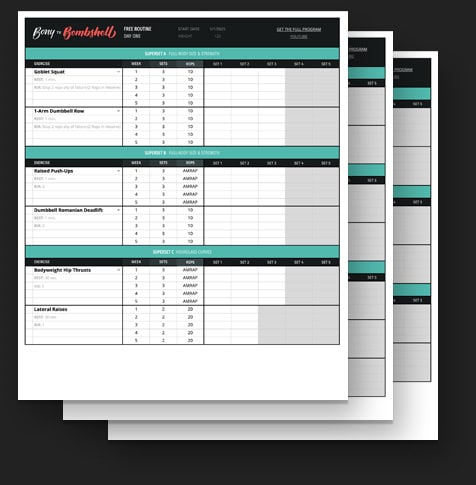
Get the glute targeting workout as a Google spreadsheet. You’ll be able to pick from exercise alternatives, and fill out the sheet.
Plus, we’ll make sure you’re on the Bony to Bombshell newsletter, and send you all of our best women's muscle-building content.
The Squat
The squat can be done with a dumbbell or barbell, and the goal should be to sink as deep as you can without needing to round your lower back. The deeper you can go, the more of a stretch you’ll get on your glute muscles, and the more muscle you’ll be able to build. (We’ve got a full squat guide here.)
Here’s Marco with Simone, demonstrating the Goblet Squat:
What’s interesting is that because squats work the glutes through such a deep range of motion with such a heavy load, they may stimulate even more glute growth than glute isolation exercises like the hip thrust. That’s because with the squat, the hardest part of the lift is near the bottom, when our glutes are stretched. With other lifts, such as the hip thrust, the hardest part is at the top of the lift, when our glutes are contracted—that’s not nearly as good for building muscle.
Now, this doesn’t mean that you shouldn’t also be doing hip thrusts. Hip thrusts have the advantage of putting more emphasis on your hips. If your hips are stubborn, or if you’re trying to build a physique with disproportionately big glutes, it can help to include lifts that only train your glutes, like the glute bridge or the hip thrust.
But this does mean that the heavy compound lifts that work your glutes through a large range of motion—squats and Romanian deadlifts—should be your main glute exercises. After that, we could pop in some high-rep isolation work, such as hip thrusts, glute bridges, lunges, and so on.
The Romanian Deadlift
The deadlift is the main compound hip exercise. The squat gets more of the movement from the knees (which works the quads), whereas the deadlift gets more of the movement from the hips (which works the hips and hamstrings). This allows for an even deeper stretch on your glutes and results in even more muscle growth.
As with the squat, the goal should be to gradually work towards a larger range of motion and heavier weights. Fight for a little bit of progress every workout. As you get stronger at it, your hips will grow bigger.
There are a number of different deadlift variations, but the one you might be most interested in is the Romanian deadlift, given that it puts less emphasis on the upper back and more emphasis on the hips. (It’s also one of the easiest variations to learn.)
The Romanian deadlift, done with either dumbbells or a barbell, is perhaps the single greatest glute exercise. It allows us to use heavy weights, it works our glutes (and hamstrings) through a large range of motion, and it maximally challenges our glutes in a stretched position.
The Glute Bridge
The glute bridge has a fairly small range of motion and it doesn’t challenge our glutes in a stretched position, but it does allow for fairly heavy loading, and it can be a great exercise for building up a pump in the glutes. When done in combination with squats and deadlifts, they can do a great job of speeding up glute growth.
The Hip Thrust
The hip thrust extends the range of motion of the glute bridge, which is great, but the beginning of the range of motion is still quite easy, so it still isn’t as ideal for building muscle as the squat or deadlift. Furthermore, heavy barbell hip thrusts can require specialized equipment and can get a bit finicky.
A good variation for people training at home or at a regular gym is to do them with your body weight, doing as many reps as you can until you hit failure. Then, when you can do more than thirty reps, switch to the single-leg variation, and keep building. Here’s Marco doing the single-leg hip thrust.
Eventually, you’ll be able to use a dumbbell, and then a barbell if needed.
The Step-Up
Step-ups are another example of an exercise that challenges the glutes in a stretched position, making them great for building bigger hips. Start with a lower step and, as that becomes comfortable, you can work your way to even higher step-ups.
The more of a stretch you can get at the bottom of the lift, the better it will be for building glute muscles. But the catch is that you need to feel sturdy while doing them, otherwise your balance and coordination will be challenged more than your muscles.
Glute Activation Exercises
Most of your muscle growth will come from the heavier lifts you’re doing. Still, there’s also a role for smaller glute exercises if they help you develop more of a mind-muscle connection with your glutes, if they help you lift with a deeper range of motion, or if they help you lift with better posture.
Two glute activation exercises are particularly handy, and you can slip them into your warm-up routine before doing your squats and deadlifts.
The Bird Dog
The Clamshell
There are plenty of other exercises that are great for building bigger hip and glute muscles. Here are a few great exercises for building bigger hips:
- Lunges
- Reverse Hypers
- Donkey Kick
- Band Standing External Rotation
- Mini-band Walk
- Frog Pump
Free Female Beginner’s Full Body With Glute Targeting Workout
GET THE free GOOGLE SPREADSHEET OF THE
female BEGINNER’S FULL-BODY with glute targeting WORKOUT

Get the glute targeting workout as a Google spreadsheet. You’ll be able to pick from exercise alternatives, and fill out the sheet.
Plus, we’ll make sure you’re on the Bony to Bombshell newsletter, and send you all of our best women's muscle-building content.
Frequently Asked Questions About Wider & Curvier Hips
How Heavy Should You Lift Weights?
Your hip muscles will grow well with anywhere between 4–40 reps, but they’ll grow best with 6–12 reps per set. Our muscles respond well to both heavy (five or fewer reps before your muscles give out) and lighter weights (twenty or more reps before your muscles give out). Your glutes are no exception. You should use a blend of heavy compound lifts, lighter compound lifts, and extra isolation work to help grow your butt optimally.
However, the most efficient way to build bigger muscles is to focus most of your effort on moderate rep ranges. Anywhere from 6–20 reps is ideal for gaining muscle size, avoiding injury, keeping your joints strong, and avoiding fatigue. That doesn’t mean that you should only lift in that rep range, just to put more emphasis on it.
How Often Should You Train Your Glutes?
We recommend training your glutes three times per week, ideally with a day of rest between workouts. You can also train all of your other muscles during those same workouts. No need to only do glute exercises.
For more, here’s our article teaching a sample beginner workout routine.
Are Squats Good for Building Bigger Hips?
Squats are a knee-dominant exercise. They’re best for building your quads. However, they’re also a great glute exercise, and can help you build bigger hips. Squats are great for developing your overall strength and athleticism, and they will help you build wider hips, especially as you get stronger at them. Just keep in mind that if your quads are giving out before your butt, then your quads may get more of the growth stimulus than your glutes.
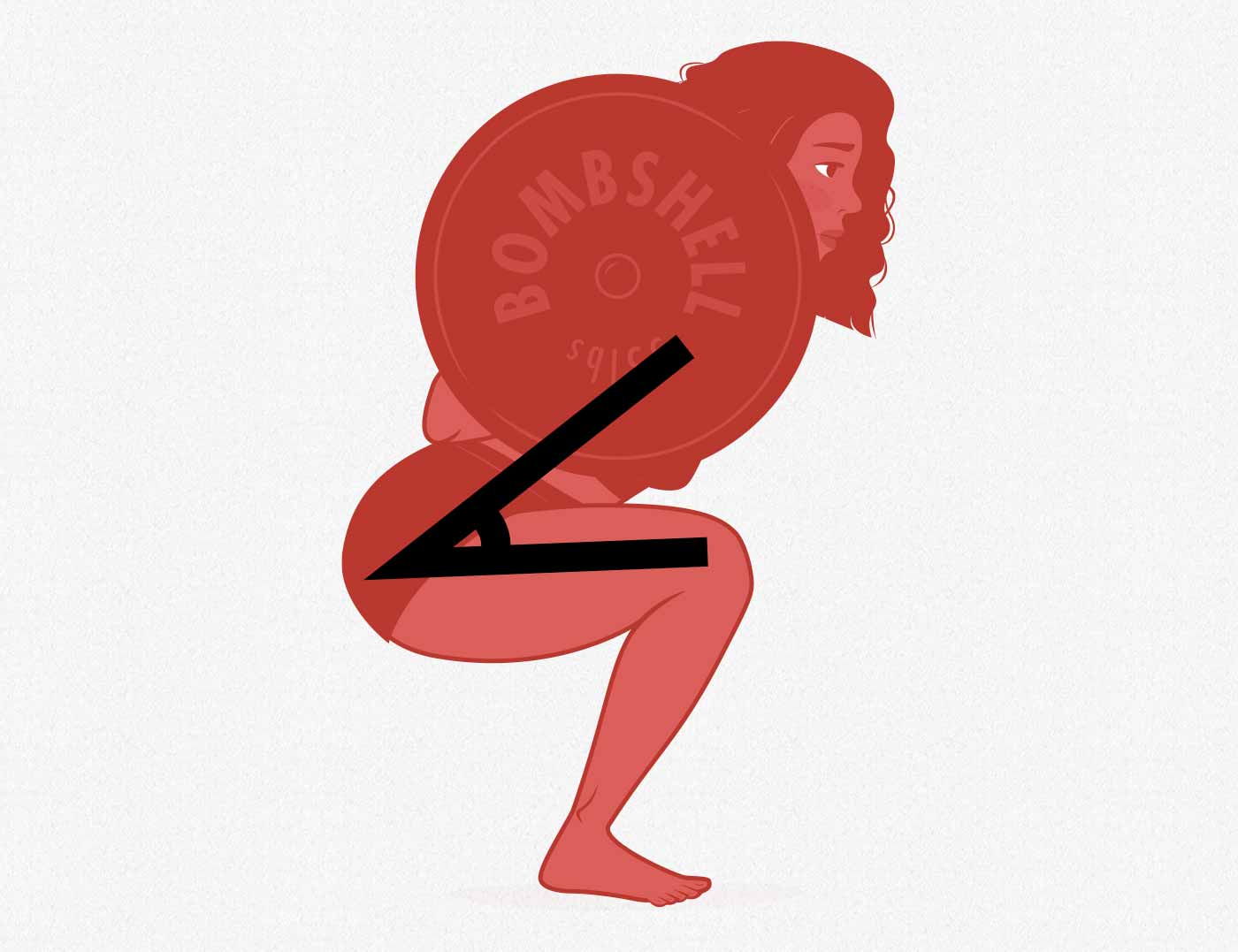
One tip you can use to make your squats hit your butt a bit harder is to focus on driving your hips back. Sitting back instead of sitting down. But the main thing is to squat as deep as possible, getting as deep a hip angle as you can manage. The deeper you stretch your glutes, the better they’ll grow.
For more, we’ve got a full article on how to squat.
Are Deadlifts Good for Building Bigger, Curvier Hips?
Deadlifts and other standing hip-hinge variations (such as good mornings) are generally the best exercises for building bigger glutes. Deadlifts are centred around bending at the hips, whereas squats are centred around bending at the knees. This means that with a deadlift, you’ll be doing a deeper and fuller hip movement. And along with stimulating your hips, the deadlift will also work the rest of your posterior chain: spinal erectors, upper back, hamstrings, and grip.
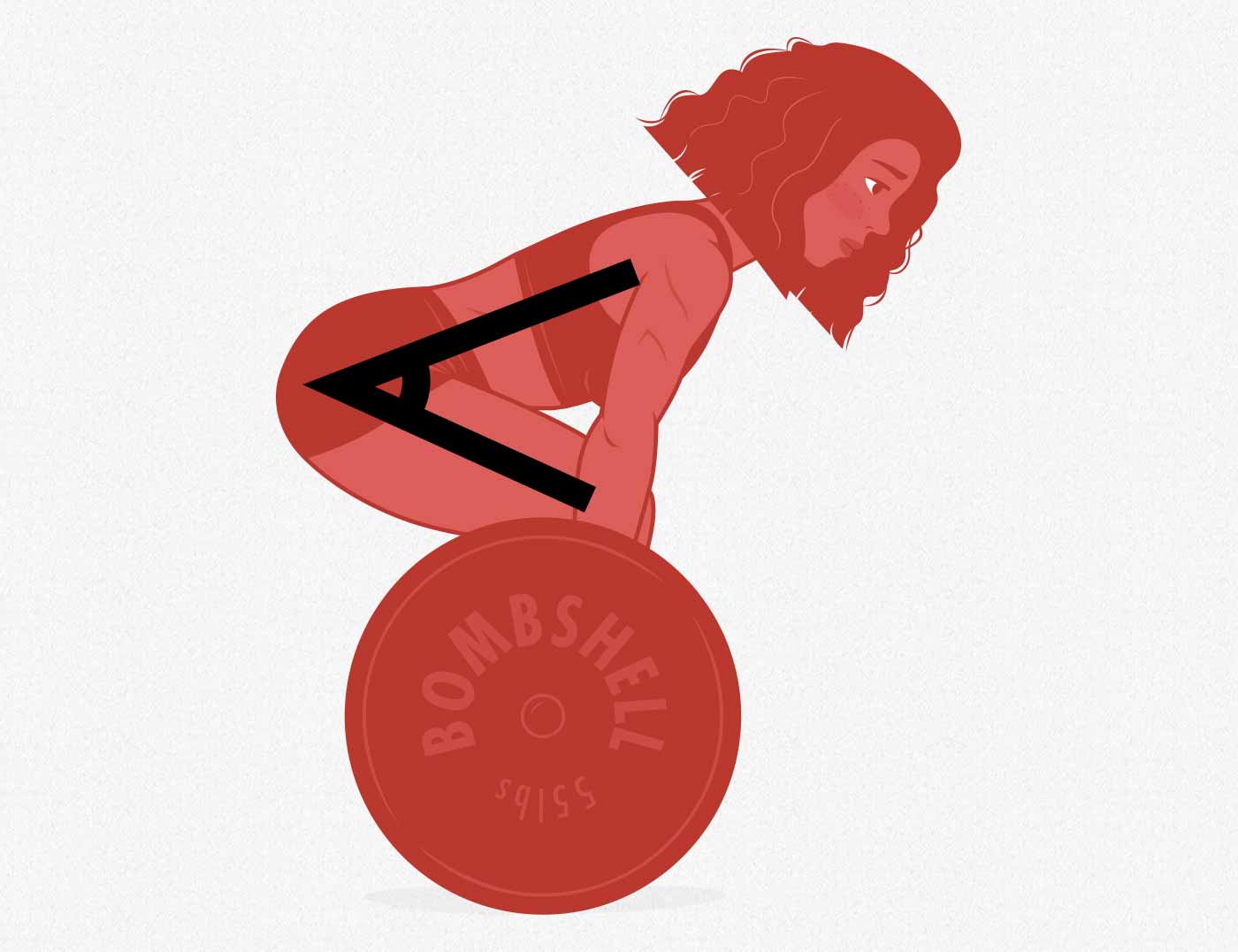
However, this doesn’t mean that you’re forced to do a conventional barbell deadlift from the floor. There are plenty of different deadlift variations that will better match your experience level, preferences, and goals. For example, one good deadlift variation for building up your hips is the Romanian deadlift. This allows you to work your hips through their full range of motion while keeping constant tension on them, and it takes some of the strain off your quads, spinal erectors, and upper back.
(I would also technically include glute bridges and hip thrusts as variations of the deadlift, given that they’re hip extension lifts. So after doing your deadlifts, these would make great follow-up lifts.)
The takeaway message here is that your program should include both squats and deadlifts. That will ensure that your hips are worked in a variety of ways and that all of the various muscles in your hips will grow.
We can take this one step further, too, including isolation lifts that focus on building up a bigger butt and wider hips.
Are Glute Bridges or Hip Thrusts Better for Building Bigger Hips?
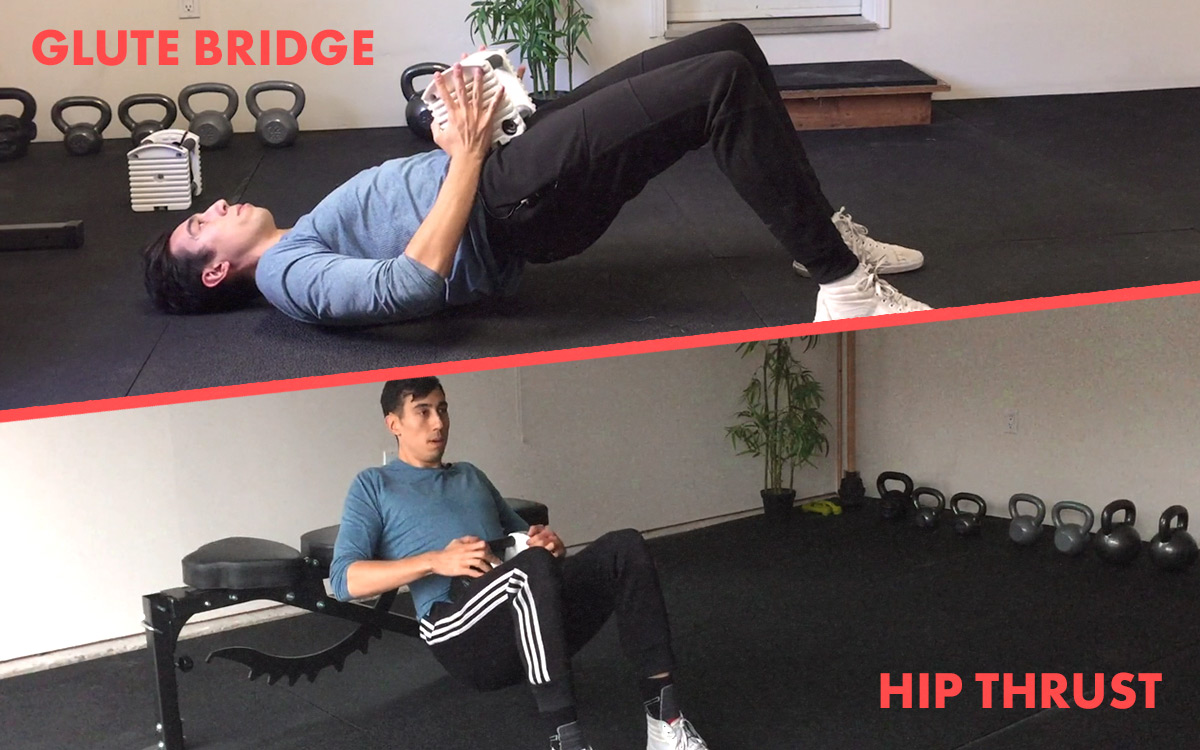
When it comes to isolation lifts for building wider hips, the glute bridge and hip thrust will be your go-to exercises. We have an entire article dedicated to comparing the hip thrust to the glute bridge.
According to most EMG research which measures muscular contractions (which should be taken with a grain of salt), hip thrusts activate our glutes better than glute bridges do.
So, someone might ask, “why would you ever do a glute bridge if it’s inferior at stimulating the glutes?” They might also add, “Plus, you just talked about using a large range of motion, and the glute bridge has less range of motion than the hip thrust.”
Still, we include the glute bridge in our own program for a few reasons. Why?
Progression: Glute Bridges Are Easier to Learn Than Hip Thrusts
The first reason is progression. Many women don’t have the core control to do the hip thrust without disconnecting their ribs from their pelvis. That means they’ll probably feel a lot of pain in their back instead of a burn in their glutes. This increases the risk of pain and won’t stimulate the glutes properly.
So we teach a simpler progression first: the glute bridge. This allows someone to roll the weight over their hips, get into position, and just push. Simple. And their form will get more locked in over time, allowing them to progress to the hip thrust.
Heavier Loading: Glute Bridges Have More Mechanical Tension Than Hip Thrusts
The second reason that glute bridges can be helpful is that you can load them up with a much heavier weight because the exercise uses a smaller range of motion. This means you can glute bridge far more weight than hip thrust. This can be an excellent way to add safe ultra-heavy lifting to your training. Powerlifters use this trick all the time by doing partial squats, rack pulls, etc.
More Isolation: Glute Bridges Isolate the Glutes Better Than Hip Thrusts
The third reason is that compared to hip thrusts, glute bridges are far better at taking the thighs (quads and hamstrings) out of the picture. So even though it might activate less of the glutes objectively per rep compared to hip thrusts, it also isolates the glutes better. Since building wider hips is all about proportions, it helps to have an exercise that grows the hips and only the hips, allowing you to boost that aspect of your proportions.
More Exercise Variety for Your Hips
Finally, as mentioned above, the best way to build rounder and fuller hips is to get strong at various glute exercises. This will ensure that you’re growing all of the muscle fibres that run through your hips, including all of the fibres in your glutes and the myriad of other muscles in your hips.
The takeaway is that your training program has a place for both glute bridges and hip thrusts. Whether you’re a beginner or an advanced lifter (or somewhere in between), this remains true.
Summary
To build bigger, curvier hips, you to do exercises that challenge the muscles in your hips—your glutes. You have a couple of different glute muscles: your gluteus medius and maximum. Both contribute to the overall size and shape of your hips.
Your gluteus maximus muscles are your butt muscles. They’re the bigger and stronger muscles, and they’re trained perfectly with lifts like the Romanian deadlift, squat, and hip thrust. This is where you’ll see the most growth, and this is where you should invest the bulk of your time.
Your gluteus medius muscles are your hip muscles. They’re smaller and more postural. They’re trained with a variety of compound lifts and should grow in proportion with the rest of your muscles. If you want to give them a bit of extra attention, you can add in some isolation exercises like clamshells, donkey kicks, etc.
To support muscle growth, remember to eat a good muscle-building diet and get plenty of good sleep. If you aren’t recovering between your workouts, it will be hard to outlift yourself, and your muscle growth will stall.
Alright, so here’s the main re-cap:
- Big hips and a lean waist = healthy
- Divide your waist and hip measurements to get your waist-to-hip ratio.
- Aim for 0.7 for a healthy and attractive benchmark.
- Become shaped by your muscles because you can’t change your bones. You can’t change your bone structure, but you can change your waist-to-hip ratio by building a bigger butt, shrinking your waist, or both.
- To get a bigger butt, you must build new muscle.
- Eat enough protein and calories to support muscle-building
- Do glute-specific training for optimal results
- Train every hip movement: focus on getting stronger at squats and deadlifts, but also do plenty of hip thrusts, glute bridges, and other glute isolation lifts.
- Work on expanding your range of motion: the deeper you can sink into your squats and deadlifts, the more of a stretch you’ll get on your glutes, and the more muscle you’ll build.
- Using good technique will allow you to hit the right muscles the right way: focus on feeling your muscles working during your glute bridges and hip thrusts. See if you can get a good glute burn and pump while doing these lighter exercises.
- Use a variety of exercises and strategies to train your hips
- Use both compound and isolation exercises.
- Lift heavy for 4–8 reps per set (with longer rest times).
- Lift moderately for 8–15 reps per set.
- Lift lighter for 15–40 reps per set (with shorter rest times).
- Train your glutes up to 3x a week to keep them constantly growing
Whew! Done. Now you know exactly how to build bigger, curvier hips. If you liked this article, I think you’d love our muscle-building newsletter. We’ll keep you up to date on all the latest muscle-building information for women. Or, if you want us to walk you through the process of building muscle, including teaching you the lifts, giving you a full workout program, a complete diet guide, a recipe book, and online coaching, check out our Bony to Bombshell Program.

